September 2024
The global self-adhesive labels market size is calculated at USD 54.18 billion in 2025 and is forecasted to reach around USD 92.04 billion by 2034, accelerating at a CAGR of 6.07% from 2025 to 2034. The Asia Pacific self-adhesive labels market size surpassed USD 21.13 billion in 2025 and is expanding at a CAGR of 21.13% during the forecast period. The market sizing and forecasts are revenue-based (USD Million/Billion), with 2024 as the base year.
The global self-adhesive labels market size was estimated at USD 51.05 billion in 2024 and is predicted to increase from USD 54.18 billion in 2025 to approximately USD 92.04 billion by 2034, expanding at a CAGR of 6.07% from 2025 to 2034. The increasing industrial and manufacturing development is driving the growth of the market.

The Asia Pacific self-adhesive labels market size was estimated at USD 19.91 billion in 2024 and is predicted to be worth around USD 36.36 billion by 2034 with a CAGR of 21.13% from 2025 to 2034.

Asia Pacific led the self-adhesive labels market with the largest share in 2024. The growth of the market in the region is expected to sustain its dominance due to the rising population, urbanization, and industrial development in the regional countries driving the growth of the market. Due to the rising consumer base and disposable income in the population, the increasing consumer goods industry drives the demand for personal consumer goods to pharmaceuticals, which accelerated the demand for self-adhesive labels for providing information, pricing, and regularity standards on products. Thus, the rising industries are driving the growth of the self-adhesive labels market in the region.

North America is expected to witness significant growth during the forecast period. The market's growth is attributed to the higher demand for consumer goods due to higher per capita income in the population and the higher presence of economically stable countries, resulting in the increased industries and manufacturing sectors in the region. Thus, the increased presence of the major industries and manufacturing companies is contributing to the growth of the self-adhesive labels market in the region.
Self-adhesive labels are pressure-sensitive labels. It can easily be versatile and can stick on various surfaces like materials, including plastics, glass, cardboard, and metals. It sticks when the pressure is applied to the label. There are two types of self-adhesive: permanent and removable. Removable labels are more commonly used in a wide range of applications, such as temporary company systems, promotional stickers, pricing labels, and others. Permanent labels are durable and last longer; they are commonly used in product labeling, branding, and identification. Self-adhesive labels come in a number of variants, small and large. The large self-adhesive labels enable more information and are an excellent tool for promotional and branding activities. The rising consumer segment and the increasing product marketplace are driving the demand for the self-adhesive labels market.
| Report Coverage | Details |
| Market Size in 2025 | USD 54.18 Billion |
| Market Size by 2034 | USD 92.04 Billion |
| Growth Rate from 2025 to 2034 | CAGR of 6.07% |
| Largest Market | Asia Pacific |
| Base Year | 2024 |
| Forecast Period | 2025 to 2034 |
| Segments Covered | Type, Label Type, Application, and Regions |
| Regions Covered | North America, Europe, Asia-Pacific, Latin America, and Middle East & Africa |
Increasing consumer goods industry
The rising global population drives the demand for the consumer goods industry, and the demand for FMCG is highly contributing to the growth of the market. Self-adhesive labels are used to label and provide accurate information about the ingredients, quality, quantity, pricing, and others. The increasing demand for clothing, packaged foods, consumer durables, electronics, and goods in the population due to rising disposable income in economically developed countries is driving the demand for self-adhesive labels. Additionally, the rising demand for self-adhesive labels in manufacturing, agriculture, consumer goods, pharmaceuticals, and others is further driving the growth of the self-adhesive labels market.
Availability of alternative products
Some labelling alternatives can be integrated more seamlessly into existing production lines, potentially improving operational efficiency. For example, the use of in-mold labelling can streamline the manufacturing process by combining labelling and moulding into a single step. Some alternative labelling technologies allow for greater customization and versatility. Sleeve labels, for example, can cover the entire surface of a container, providing more space for branding and information, and can be applied to complex shapes that self-adhesive labels might not adhere to effectively. Thereby, the availability of alternative products is a major restraint for the self-adhesive labels market.
Rising urbanization and growing marketplaces
The rising urbanization and consumer market base in economically developing nations due to the people's rising per capita income and demand for packaged goods are driving the demand for the self-adhesive labels market. Self-adhesive provides clear product branding, identification, and other information. The population's rising demand for aesthetically appealing products also boosts the growth of a wide range of industries. The rising investment in the industrialization and manufacturing and packaging industry is driving the demand for self-adhesive labels. Additionally, rising e-commerce marketplaces are also boosting the growth of the market.
Technological advancements
Technological progress in adhesive formulations can result in labels that adhere more effectively to a wider variety of surfaces, including challenging materials and conditions (e.g., extreme temperatures, moisture). Advances in materials science have led to the development of biodegradable and recyclable self-adhesive labels. These eco-friendly options appeal to environmentally conscious consumers and help companies meet sustainability goals. Improvements in printing speeds without compromising quality can increase production efficiency and reduce turnaround times, making self-adhesive labels more competitive.
The release liner segment dominated the self-adhesive labels market with the largest market share in 2024. The release liners are also called the backing or carrier. It is used to protect the labels, act as protective layers, and keep them safe until the label is ready to use. The release liner is made of poly-coated paper, paper, and other materials like films and metalized paper. Two major types of release liners are paper and PET film. PET liners are highly used in the manufacturing industries due to their higher capacity for fast labeling.
PET liners are also used in the wet condition. PET liners are made of polyester film, though they are thinner in density than paper liners, so they can roll more labels on each roll. This saves more time and cost due to the less damage or breakage in the machine roll as compared to paper rolls. Thus, the increased consumption of release liners for several product labeling drives the expansion of the segment in the self-adhesive labels market.
The permanent label segment dominated the self-adhesive labels market in 2024. There is a rising use of permanent labels in various industrial labeling such as pharmaceutical, construction, and shipping. Permanent labels are stronger than removable labels; they are durable and highly temperature resistant. Permanent labels are water resistant, though they can be used in the food and beverages industry.

The medical industry is highly using high-quality permanent labels. Products like medical equipment, laboratory specimens, and pharmaceutical safety labels are used for permanent labeling. The construction industry is further using permanent labels due to the equipment handled in extreme situations and harsh weather; the labeling on construction equipment advertises safety and usage standards that cannot fall off. Thus, permanent labels are preferred in the construction industry.
The food and beverages segment dominated the self-adhesive labels market in 2024. The rising global population and the population diverting to ready-to-use food products, packaged food products, and beverages due to the faster lifestyle and rising growth in economic wealth are driving the demand for self-adhesive labels in the food and beverages industry. There are strict regulations from the various regional governments to show content on the food labeling or packaging. Labels consist of information regarding the food products, such as nutritional content, shelf-life, manufacturing and expiry dates, manufacturer, and others. That drives the demand for high-quality labeling for the product.
The rising adoption of convenience food and average products in the market is further driving the growth of the market. Thus, the increasing market competition and food delivery partners are highly contributing to the demand for self-adhesive labels in the food and beverages industry.
By Type
By Label Type
By Application
By Geography
For inquiries regarding discounts, bulk purchases, or customization requests, please contact us at sales@precedenceresearch.com
No cookie-cutter, only authentic analysis – take the 1st step to become a Precedence Research client
September 2024
August 2024
February 2025
January 2025